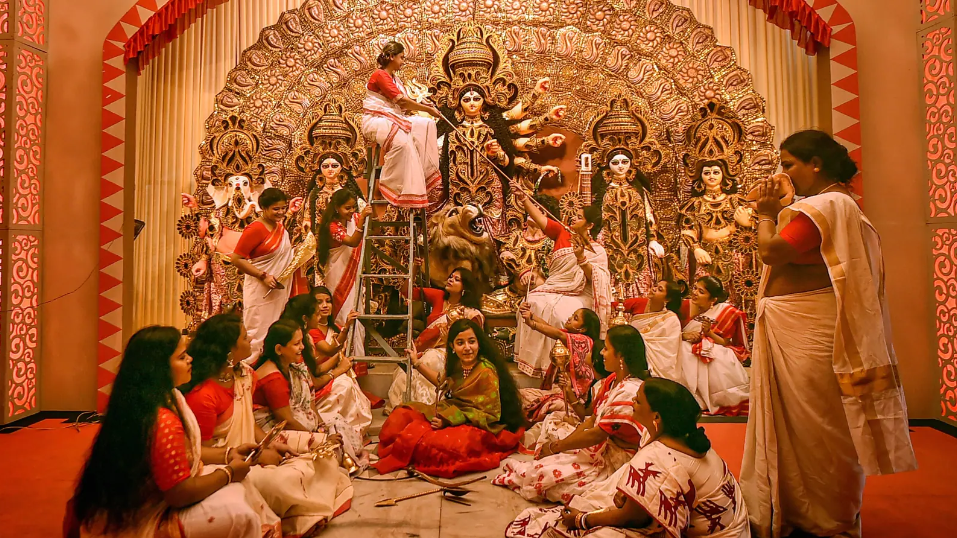South Asian Wedding Traditions
Credit: Bridal Guide
When we think of South Asian weddings, a lot of us imagine vibrant colors, huge crowds of guests, and elaborate ceremonies. Many Indian and South Asian weddings take place over several days, and they're usually rich in culture and tradition that are based on family origin. Because there are so many different cultures in South Asia, there are also dozens of different wedding traditions. However, the entire family is usually involved in planning and organizing the big event. A wedding isn't just a celebration of the union of two partners; but a blending of two families. Below, we discuss some of the many South Asian wedding traditions.
Credit: GaneshaSpeaks
Determining the Muhurat
Unlike Western weddings, which usually take place during the weekend, the day in which South Asian weddings take place are chosen very carefully. A pandit (Hindu priest) decides the most auspicious day (or Muhurat) that the couple should get married based on their horoscopes. It is believed that the day and time during which the two get married will impact their future together. After this day is decided, the couple will send out wedding invitations to their family and friends.
Credit: Hindustan Times
Puja or Path
Before the couple’s wedding, a religious ceremony known as a puja (Hinduism) or path (Sikhisim) takes place. They can take place either at home or in a place of religious procession such as a temple or gurudwara. Prayers are often made to Lord Ganesh, the god of wisdom, and Lord Vruna, the god of water. They are performed to bestow good luck upon the couple and their families by warding off any obstacle or hindrance they may face as they begin their new life together.
Credit: The Wedding Cards Online
Sangeet
Another ceremony held before a South Asian wedding is a Sangeet, meaning “sung together” in Sanskrit. Another word for this event is Gaun, or “songs/sing” in Hindi. It is usually hosted by the bride’s family a night before the wedding. Sangeets are a great way to get the families together, eat, dance, and play music. Sangeets usually start with a Tilak ceremony, where religious prayers are shared and a red dot is placed on the groom’s forehead by a maternal uncle or other family member. The red dot, called a tilak, is said to protect the groom from evil spirits. Throughout the Sangeet, gifts are usually exchanged between both sides of the family. This ceremony is a great way for the bride and groom’s family members to get to know each other better and celebrate.
Credit: WeddingWire.in
Mehendi
A Mehendi is a ritual when a Henna artist draws intricate designs on the bride and her family guests. These designs are drawn on their hands and feet using a paste of ground henna leaves. Henna is believed to ward off evil, promote fertility, and attract good energy for the soon-to-be wedded couple. In many instances, the groom’s name is hidden in the artwork that he is meant to find on the night of their wedding.
Credit: Lin and Jirsa Photography
Baraat
In Hindu and Sikh weddings, the groom is led to the wedding venue and is joined by his friends and family, all while the bride is hidden away, watching from a windsor or balcony. He will typically ride in on a white horse wearing a costume that matches the colors of the wedding, but he can also come in on a motorcycle, luxury vehicle, or even an elephant. Music is played while he enters, and the guests will dance and celebrate on their way to the venue. When the groom reaches the venue, the bride’s female relatives will greet him and his family.
Credit: WeddingWire.in
Mandap
For Hindu weddings, the ceremony will usually take place under a structure with a canopy called a Mandap. The four pillars of the Mandap represent the parents of the bride and groom. It is usually beautifully decorated with draping, beading, flowers, and bright colors. Traditionally, the parents of the couple are seated at the Mandap with the officiant. When the wedding begins, a ceremony will take place under the Mandap called Granthi Bandhanam. During this ceremony, the bride and groom are “tying the sacred knot” by being tied together. The bride’s brother will tie a white cloth to her sari, with the other end draped over the groom’s shoulder. This knot symbolizes the unity between their two families, bonding as one.
Credit: ShaadiWish
Saptapadi
The Saptapadi, or seven steps, occurs after the Granthi Bandhanam. It represents the promises the couple is making to each other and their families:
1. Let us provide for our household, stay in good health and carry out our duties and responsibilities to each other, our families and our tradition.
2. Let us develop our mental and spiritual powers
3. Let us increase our wealth and comfort by righteous and proper means
4. Let us acquire knowledge, happiness and harmony by mutual love, respect and trust
5. Let us be blessed with contended family of strong, virtuous and heroic children
6. Let us be blessed with long lives
7. Let us remain true companions, committed only to each other
There are many regional differences that occur when performing Saptapadi. In South Indian tradition, it is customary that the couple take seven steps due south, with the groom leading his bride by her pinky finger around the fire. The alternating positions of the couple, as well as who is leading each step, will vary across the country based on region and religion.
From intricate mehndi designs to the beautiful promises of Saptapadi, South Asian wedding traditions demonstrate more than love between two partners, but a union between their two families, forming into one. These traditions are all about bringing communities together, forging lifelong connections, and creating memories that will last a lifetime. Whether you’re part of a South Asian family, preparing for a wedding or you’re a curious learner, these traditions are a beautiful demonstration of the rich diversity of our world.
If you want to read more about beauty, skincare, and wedding tips, or if you want to learn about our bridal services, check out the rest of our website at cinderellabridez.com. Or if you want to learn about our CEO’s journey as a small business owner, visit her website at barbiepatel.com!








